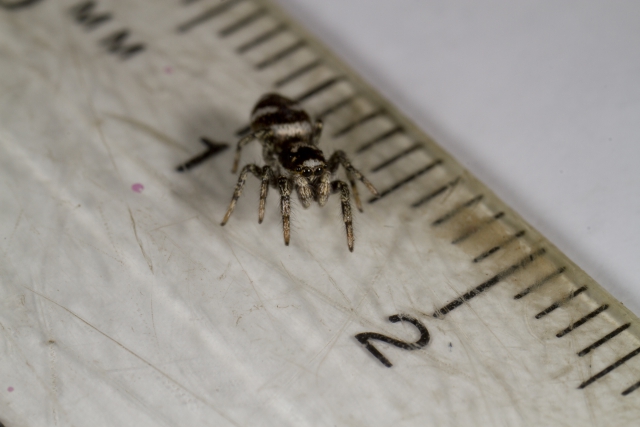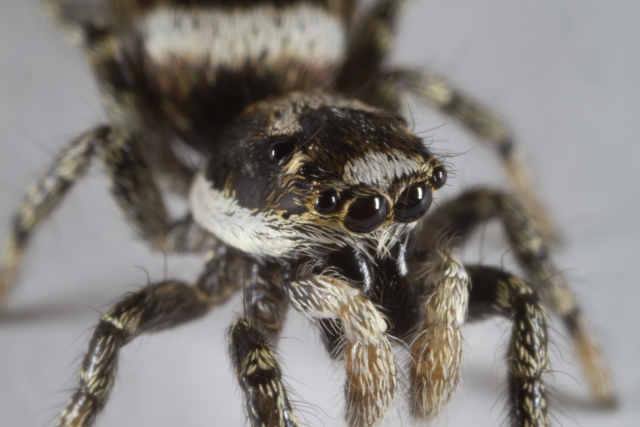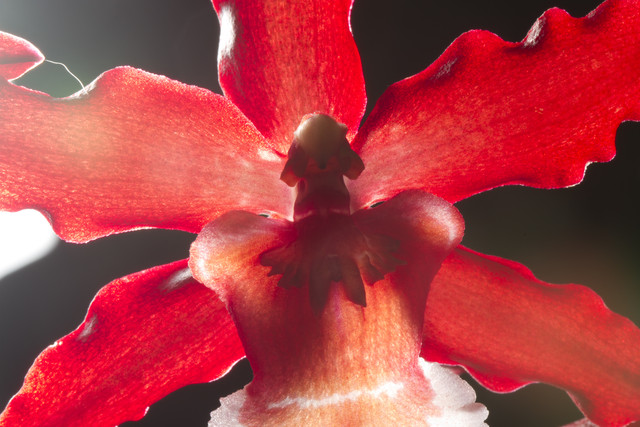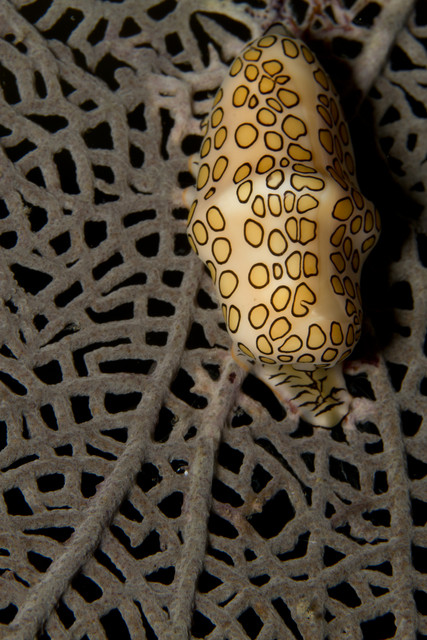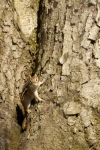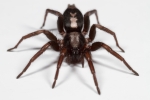macro
Wake Up, Spider
ktuli — Sun, 03/25/2012 - 20:25
I found this little (again - in the 5mm or smaller size range) spider on my way home from work on Friday. I brought him home and moved him to a slightly larger container. He quickly decided it was time to take a nap, and make a small cocoon type web on the lid of the container and curled up to get some rest.
Later, when I went to take some photos, I thought it would be nice to get him still in the little blanket of silk. Unfortunately, he quickly woke up and was just climing out of his little hammock when I managed to fire off this one shot.
I really like this pose as it is different from what you would normally see for a spider. I'm a bit disappointed that the very top of the spider's head got cut off by the top of the frame. Also, the depth of field is pretty shallow (f/8 as opposed to the f/16 I usually shoot with this lens), and from this profile angle makes very little of the spider in focus. I also really like the blue background, and may have to try and use it more often and find some others that work well too. On top of that, this shot is at 5x magnification, so all things considered, I am pretty pleased with it.
Technical Data: Canon EOS 7D, Canon MP-E 65mm f/2.8 1-5x Macro, 1/40 sec at f/8. Canon Macro Twin Lite MT-24EX in ETTL mode. ISO 100. RAW processing in Adobe Camera Raw.
I have a few more to share of this spider, but I promise to take a short break from the spiders here and post a few I took at Powdermill Nature Reserve.
- Bill
Cool Spider: Reference Shot
ktuli — Tue, 03/20/2012 - 20:18
Just stopping by real quick to share a shot that shows just how small that jumping spider was...
Technical Data: Canon EOS 7D, Canon MP-E 65mm f/2.8 1-5x Macro, 1/250 sec at f/13. Canon Macro Twin Lite MT-24EX in ETTL mode. ISO 100. RAW processing in Adobe Camera Raw.
Hopefully that puts that 5x magnification in the shot from the other day into a little perspective.
- Bill
Cool Spider
ktuli — Sat, 03/17/2012 - 19:59
So I tried something new with this little guy. I've read that if you put a spider or insect in the fridge, it slows them down and makes it easier to get photos of them. I don't know if I was doing it wrong or what, but I would put this little fella in the fridge for about 10-15 minutes and it would only slow him down for a second or two before he was back up and running around.
Additionally, this shot was done at 5x magnification, so while the shots below were cropped, this one is as it was in camera...
Technical Data: Canon EOS 7D, Canon MP-E 65mm f/2.8 1-5x Macro, 1/250 sec at f/13. Canon Macro Twin Lite MT-24EX in ETTL mode. ISO 100. RAW processing in Adobe Camera Raw.
Enjoy!
- Bill
Jumping Spider: Square Crop
ktuli — Mon, 02/27/2012 - 17:37
I tried some square crops on this recent batch of jumping spider shots... what do you think?
 |
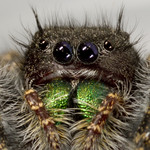 |
 |
|
Technical Data: Canon EOS 7D, Canon EF 100mm f/2.8L Macro IS USM, 1/200 sec at f/11. Canon Speedlight 580EX II flash in auto mode and wireless control. Image Stabilization on. ISO 100. RAW processing and cropped in Adobe Camera Raw. Canon EOS 7D, Canon MP-E 65mm f/2.8 1-5x Macro, 1/250 sec at f/16. Canon Macro Twin Lite MT-24EX in ETTL mode. ISO 100. RAW processing and cropped in Adobe Camera Raw.
- Bill
First Spider of 2012
ktuli — Sun, 02/26/2012 - 14:35
I generally don't mind winter, but there is certainly one thing I dislike about the colder months - the lack of spiders and insects to shoot. Luckily, Anya has no problem promoting my love of shoot bugs, and so when she saw a jumping spider crawling around her office at work, she found a container to bring it home so I could take some photos of it.
It is always a challenge to work with a spider when it isn't in its normal environment. They will either hide or run - neither behavior really lends itself to photography. Because it is so cold and I haven't been getting many opportunities to work with spiders, we decided to keep this guy around for a bit. We put him in one of the larger containers I have from when I kept lots of reptiles and such, found him some leaves and such from house plants to use as hiding spots, and finally bought him a bunch of crickets to fatten him up during these lean times as some sort of compensation for the stress I may be inducing. Anyway - here we go...
Technical Data: Canon EOS 7D, Canon EF 100mm f/2.8L Macro IS USM, 1/200 sec at f/11. Canon Speedlight 580EX II flash in auto mode and wireless control. Image Stabilization on. ISO 100. RAW processing and cropped in Adobe Camera Raw.
This shot originally was a vertical shot, but I liked this crop better and went with it - in particular, I like the lean the spider has to naturally set the balance of the shot. Also, the shot was taken on a white cardboard box, which I definitely like how that makes the shots look, and so will likely try that again in the future (though I think it adds to the way the spider doesn't like to sit still).
I'm just happy to have spiders to start working with again.
- Bill
Snowflakes
ktuli — Sun, 02/12/2012 - 18:50
I had thought about heading out today to see about finding a place to try some winter wildlife photography - particularly looking for deer in the snow. However, it was just far too cold try do that, so I thought about what I could shoot around here.
I still headed out into the cold, but this time with the MP-E 65mm to see whether I could get any super macro shots of some snowflakes. I'd seen something somewhere (I can't remember where) of photos of individual snowflakes, so I figured I would see if I could do the same.
 |
 |
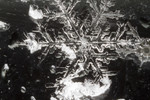 |
 |
||
Technical Data: Canon EOS 7D, Canon MP-E 65mm f/2.8 1-5x Macro, 1, 10, 3.2 sec respectively at f/16. ISO 400. RAW processing in Adobe Camera Raw.
First - finding individual snowflakes is much more difficult than you would think. Any time I would try and look where there was any noticeable amount of snow, it was nearly impossible to distinguish individual flakes. I ended up figuring out that I could find some on the windows of Anya's truck. Even there, I only managed to find maybe half a dozen at a time. And if that wasn't enough of a challenge, I could literally watch the flakes melt in front of me once I did find them.
When I started, I was using my MT-24EX dual macro flash, but I found it was causing far too much in terms of reflections, so I turned it off and went to long exposure times. As you can see, the longest of which went all the way up to 10 seconds.
All of these shots were done at 5x magnification, so dealing with focus was extremely challenging. Anya bought me a macro focusing rail for my birthday, which greatly helped, but at 5x magnification, the slightest movement makes a huge difference in the focus.
This is definitely another subject I'll have to try again in the future - it is just so cool to see such an intricate and unique subject at such magnifications.
- Bill
Backlit Orchid
ktuli — Thu, 02/09/2012 - 17:43
For this shot, I asked my lovely assistant to position my flash behind the orchid to produce a different view and get those nice highlights along the edges of the petals...
Technical Data: Canon EOS 7D, Canon EF 100mm f/2.8L Macro IS USM, 1/200 sec at f/22. Canon Speedlight 580EX II flash in auto mode and wireless control. Image Stabilization on. ISO 100. RAW processing in Adobe Camera Raw.
- Bill
Super Macro: Blue Jay Feather
ktuli — Tue, 02/07/2012 - 20:04
This year, I started a "Project 52" to keep myself motivated to take photos on a regular basis. I've already hit some rough times getting good ideas of things to shoot, but last week I came up with the idea to shoot a blue jay feather with my new super-macro lens - the Canon MP-E 65mm.
The results were not nearly as good as I wanted, and I almost dumped the whole lot of them. Instead, I kept them and I will use them in the future to refer back to in order to correct the mistakes I made.
 |
 |
 |
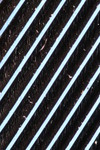 |
 |
Technical Data: Canon EOS 7D, Canon MP-E 65mm f/2.8 1-5x Macro, bottom-left with Kenko Teleplus PRO 300 "DG" AF 2x Teleconverter, top-left with Canon Speedlite 580EX II, others with Canon Macro Twin Lite MT-24EX in ETTL mode. Assorted exposures. ISO 100.
The shot in the bottom-left is actually a 10x magnification as I had my 2x teleconverter combined with the MP-E 65 set to 5x magnification. The clarity on it isn't as good as I would have liked, so I'm sure I will be retrying that at some point as it certainly is an interesting shot.
- Bill
Caribbean Explorer: Fireworm Assortment
ktuli — Sun, 02/05/2012 - 13:15
I'm getting anxious to get back in the water... I wouldn't even mind taking photos of more fireworms...
 |
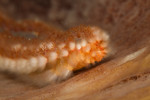 |
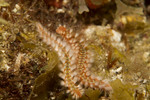 |

|
||
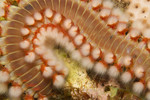 |
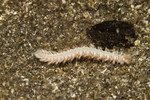 |
 |
Technical Data: Canon EOS 7D, Canon EF 100mm f/2.8L Macro IS USM, 1/120th sec at f/16. Image Stabilization on. ISO 100. Ikelite Housing and Port with Ikelite 161 Strobe in TTL Mode. Raw conversion in Photoshop CS5.
There you can even see a little of the variety of colors with the white and green ones...
- Bill
Caribbean Explorer: Flamingo Tongue
ktuli — Tue, 01/31/2012 - 20:11
Yes - this little snail is actually called a Flaming Tongue (Cyphoma gibbosum).
We saw plenty of these little snails on a lot of the dives on this trip, and while they certainly weren't moving much, they were difficult to photograph.
One challenge was because of their diet, which consists of the polyps of soft corals. The soft corals are often branching off in many directions (much like a small bush with no leaves) and thus getting a good angle to shoot through those branches was not always easy.
Exposure always seemed to be difficult too - here you can see I ended up with some weird shadows and a still somewhat darkened shot. I'm not sure if it was the soft corals or the mantles of the Flamingo Tongues that caused the problem, but I definitely struggled getting a good clean exposure.
Regardless, they certainly are interesting little critters. While they are snails, the colorful pattern you see is not the shell which is actually white (or off-white) with no pattern - it is actually the mantle of the snail wrapping up and over the top of the shell. It can be retracted back into the shell, and for whatever reason, Mike (our dive master) always seemed to find the retracted ones while we always found the regular ones.
Also visible in this shot is the damage these snails cause as they eat the polyps on the coral - leaving whitish scar tissue. The polyps do grow back, so the damage is not permanent.
Technical Data: Canon EOS 7D, Canon EF 100mm f/2.8L Macro IS USM, 1/120th sec at f/16. Image Stabilization on. ISO 200. Ikelite Housing and Port with Ikelite 161 Strobe in TTL Mode. Raw conversion in Photoshop CS5.
- Bill


